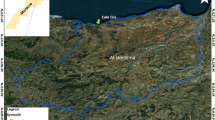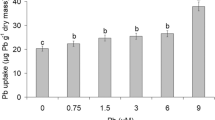Abstract
The vegetative growth and turion formation of Potamogeton crispus, a submersed aquatic macrophyte, was investigated under a range of phosphorus (P) concentrations (0.025, 0.25, 2.5 and 25 mg P L−1) in the ambient water free of algae, aiming to identify the responses of submersed aquatic macrophytes to nutrient enrichment, a common eutrophication problem in China and worldwide. Plant growth was not affected by different P concentrations in terms of biomass accumulation of stems and leaves. However, the contents of chlorophyll a and starch in plants decreased with increasing water P levels, whereas chlorophyll b and carotenoids declined with P level ranging from 0.025 to 2.5 mg P L−1. The soluble sugar content decreased when water P concentration increased up to 2.5 mg L−1. The P content in plants increased with increasing water P levels, whereas plant N content decreased and soluble protein increased when water P concentration increased over 0.25 mg L−1, implying that P. crispus may have modified its metabolism to adapt to water P availability. When P concentration increased to 25 mg L−1, the number and dry matter production of turions per plant decreased significantly. Meanwhile, there was a significant reduction in turion weight and the accumulations of soluble sugar and starch in turion, when water P concentration was over 0.25 mg L−1. The results suggest that turion formation in P. crispus is sensitive to P concentration in the ambient water, and high P levels may lead to decreases in P. crispus populations due to the decline in turion production.


Similar content being viewed by others
References
Bao SD (2000) Soil and agricultural chemistry analysis. China Agricultural Press, Beijing, pp 263–270 (in Chinese)
Carr GM (1998) Macrophyte growth and sediment phosphorus and nitrogen in a Canadian prairie river. Freshw Biol 39:525–536
Catling PM, Dobson I (1985) The biology of Canadian weeds. 69. Potamogeton crispus L. Can J Plant Sci 65:655–668
Chambers PA, Prepas EE, Bothwell ML, Hamilton HR (1989) Roots versus shoots in nutrient uptake by aquatic macrophytes in flowing waters. Can J Fish Aquat Sci 46:435–439
Chen XF, Chen KN, Xiao YE, Zhang SD, Wang QY (2006) Effects of light and matrix on turion germination, seedling growth and leaf photosynthesis efficiency of Potamogeton crispus. Chin J Appl Ecol 17:1413–1418 (in Chinese)
Dreywood R (1946) Qualitative test for carbohydrate material. Ind Eng Chem Anal Ed 18:499
Egertson CJ, Kopaska JA, Downing JA (2004) A century of change in macrophyte abundance and composition in response to agricultural eutrophication. Hydrobiologia 524:145–156
Franco-Zorrilla JM, Martín AC, Leyva A, Paz-Ares J (2005) Interaction between phosphate-starvation, sugar, and cytokinin signaling in Arabidopsis and the roles of cytokinin receptors CRE1/AHK4 and AHK3. Plant Physiol 138:847–857
Harada T, Ishizawa K (2003) Starch degradation and sucrose metabolism during anaerobic growth of pondweed (Potamogeton distinctus A. Benn.) turions. Plant Soil 253:125–135
Hu C, Zhang L, Hamilton D, Zhou W, Yang T, Zhu D (2007) Physiological responses induced by copper bioaccumulation in Eichhornia crassipes (Mart.). Hydrobiologia 579:211–218
Huang W, Chen KN, Bai X (2010) Effects of substrate nitrogen and phosphorus contents on Potamogeton crispus growth and reproduction. Chin J Appl Ecol 21:2865–2870 (in Chinese)
Janes RA, Eaton JW, Hardwick K (1996) The effects of floating mats of Azolla filiculoides Lam., and Lemna minuta Kunth on the growth of submerged macrophytes. Hydrobiologia 340:23–26
Jeppesen E, Søndergaard M, Meerhoff M, Lauridsen TL, Jensen JP (2007) Shallow lake restoration by nutrient loading reduction—some recent findings and challenges ahead. Hydrobiologia 584:239–252
Jian Y, Wang J, He G, Chen J (2001) Effects of water-depth gradients, matrices, light and removal of plantlets on germination of turions of Potamogeton crispus L. Acta Hydrob Sin 25:224–229 (in Chinese)
Jian Y, Li B, Wang J, Chen J (2003) Control of turion germination in Potamogeton crispus. Aquat Bot 75:59–69
Jupp BP, Spence DHN (1977) Limitations on macrophytes in a eutrophic lake, Loch Leven. I. Effects of phytoplankton. J Ecol 65:175–186
Klõšeiko J, Mandre M (2001) Seasonal dynamics of sugars in the leaves of Salix dasyclados and the effect of soil treatment with cement dust. Proc Estonian Acad Sci Biol Ecol 50:279–291
Koerselman W, Meuleman AFM (1996) The vegetation N: P ratio: a new tool to detect the nature of nutrient limitation. J Appl Ecol 33:1441–1450
Korn MGA, Santos WPC, Ferreira MKSL (2005) Optimisation of focused- microwave assisted digestion procedure for Kjeldahl nitrogen determination in bean samples by factorial design and Doehlert design. Talanta 65:710–715
Lauridsen TL, Jeppesen E, Andersen FØ (1993) Colonization of submerged macrophytes in shallow fish manipulated Lake Vaeng: impact of sediment composition and waterfowl grazing. Aquat Bot 46:1–15
Lauridsen TL, Jeppesen E, Søndergaard M (1994) Colonization and succession of submerged macrophytes in shallow Lake Vaeng during the first five years following fish manipulation. Hydrobiologia 275(276):233–242
Lowry OH, Rosebrough NJ, Farr AL, Randall RJ (1951) Protein measurement with the folin phenol reagent. J Biol Chem 193:265–275
Lukezic FL, Bloom JR, Levine RG (1969) Influence of top removal on the carbohydrate levels of alfalfa crown and roots grown in a gnotobiotic environment. Can J Plant Sci 49:189–195
Ma JM, Jin TX, Li J, Wu J, Wu ZB (2008) Responses of Elodea nuttallii, Vallisneria natans and Potamogeton crispus to acute stress of phosphorus. Acta Hydrob Sin 5:408–412 (in Chinese)
Madden CJ, Kemp WM (1996) Ecosystem model of an estuarine submersed plant community: calibration and simulation of eutrophication responses. Estuaries 19:457–474
Majerowicz N, Kerbauy GB (2002) Effects of nitrogen forms on dry matter partitioning and nitrogen metabolism in two contrasting genotypes of Catasetum fimbriatum (Orchidaceae). Environ Exp Bot 47:249–258
McFarland DG, Barko JW (1990) Temperature and daylength effects on growth and tuber formation in hydrilla. J Aquat Plant Manage 28:15–19
Morris K, Boon PI, Bailey PC, Hughes L (2003a) Alternative stable states in the aquatic vegetation of shallow urban lakes. I. Effects of plant harvesting and low-level nutrient enrichment. Mar Freshw Res 54:185–200
Morris K, Bailey PC, Boon PI, Hughes L (2003b) Alternative stable states in the aquatic vegetation of shallow urban lakes. II. Catastrophic loss of aquatic plants consequent to nutrient enrichment. Mar Freshw Res 54:201–215
Nishihiro J, Washitani I (2009) Quantitative evaluation of water-level effects on “regeneration safe-sites” for lakeshore plants in Lake Kasumigaura, Japan. Lake Reserv Manage 25:217–223
Phillips GL, Eminson D, Moss B (1978) A mechanism to account for macrophyte decline in progressively eutrophicated freshwaters. Aquat Bot 4:103–126
Scheffer M, Van Nes EH (2007) Shallow lakes theory revisited: various alternative regimes driven by climate, nutrients, depth and lake size. Hydrobiologia 584:455–466
Sculthorpe CD (1967) The biology of vascular aquatic plants. St. Martin’s Press, New York, p 610
Shen J, Xu W, Shi FC (2008) Effects of weight and store temperature on turion germination and seedling growth of Potamogeton crispus L. Bull Bot Res 28:477–480 (in Chinese)
Smart RM, Barko JW (1985) Laboratory culture of submersed freshwater macrophytes on natural sediments. Aquat Bot 21:251–263
Smith VH, Schindler DW (2009) Eutrophication science: where do we go from here? Trends Ecol Evol 24:201–207
Steward KK (1984) Growth of hydrilla (Hydrilla verticillata) in hydrosoils of different composition. Weed Sci 32:371–375
Sutton DL (1985) Culture of hydrilla (Hydrilla verticillata) in sand root media amended with three fertilizers. Weed Sci 34:34–39
Sutton DL, Van TK, Portier KM (1992) Growth of dioecious and monoecious hydrilla from single tubers. J Aquat Plant Manage 30:15–20
Twilley RR, Kemp WM, Staver KW, Stevenson JC, Boynton WR (1985) Nutrient enrichment of estuarine submersed vascular plant communities. 1. Algal growth and effects on production of plants and associated communities. Mar Ecol Prog Ser 23:179–191
Van den Berg MS, Joosse W, Coops H (2003) A statistical model predicting the occurrence and dynamics of submerged macrophytes in shallow lakes in the Netherlands. Hydrobiologia 506–509:611–623
Van Geest GJ, Wolters H, Roozen FCJM, Coops H, Roijackers RMM, Buijse AD, Scheffer M (2005) Water-level fluctuations affect macrophyte richness in floodplain lakes. Hydrobiologia 539:239–248
Wang L, Yang T, Zhu D, Xu J, Nie Z, Yang G (2012) Changes in propagule formation and plant growth in Potamogeton crispus induced by exogenous application of gibberellic acid (GA3) and 6-benzyladenine (6-BA). Aquat Biol 15:35–45
Wu F (2003) Studies on physiological mechanism of genotypic difference in cadmium accumulation and tolerance of barley. Doctorial degree dissertation, Zhejiang University (in Chinese)
Xue YL (ed) (1985) Laboratory manual for plant physiology, 1st edn. The Shanghai Society for Plant Physiology. Shanghai Science and Technology Press, Shanghai, pp 134–138 (in Chinese)
Yang X, Zhang X, Yu S, Wang J (2010) Analysis on efficiency of constructed wetland in treatment micro-polluted water resource and effect of plants. Chin Agric Sci Bull 26:274–278 (in Chinese)
Yemm EW, Willis AJ (1954) The estimation of carbohydrates in plant extracts by anthrone. Biochem J 57:508–514
Yoshida S, Forno DA, Cock JH, Gomez KA (1976) Determination of sugar and starch in plant tissue. In: Yoshida S (ed) Laboratory manual for physiological studies of rice, 3rd edn. International Rice Research Institute, Los Baños, Laguna, Manila, the Philippines, pp 46–49
Zhang LF (2006) Effect of water quality on the growth of submerged macrophytes (Elodea nuttalii and Potamageton crispus). Master’s degree dissertation. Hohai University (in Chinese)
Acknowledgments
We thank the National Natural Science Foundation of China (40973056) and the Natural Science Foundation of Hubei Province (2005ABA042) for financial support; Assoc. Prof. Anguo Liu for meteorological data; Assoc. Prof. Bo Qu for statistical analysis. This work was part of the Research and Demonstration on Agro-Ecological Restoration Technology in Danjiangkou Reservoir Region for the South-to-North Water Transfer Project (Grant No. 2007BAD87B09).
Author information
Authors and Affiliations
Corresponding author
Additional information
Handling Editor: Liesbeth Bakker.
Rights and permissions
About this article
Cite this article
Wang, L., Yang, T., Zhu, D. et al. Growth and turion formation of Potamogeton crispus in response to different phosphorus concentrations in water. Aquat Ecol 47, 87–97 (2013). https://doi.org/10.1007/s10452-012-9427-7
Received:
Accepted:
Published:
Issue Date:
DOI: https://doi.org/10.1007/s10452-012-9427-7




